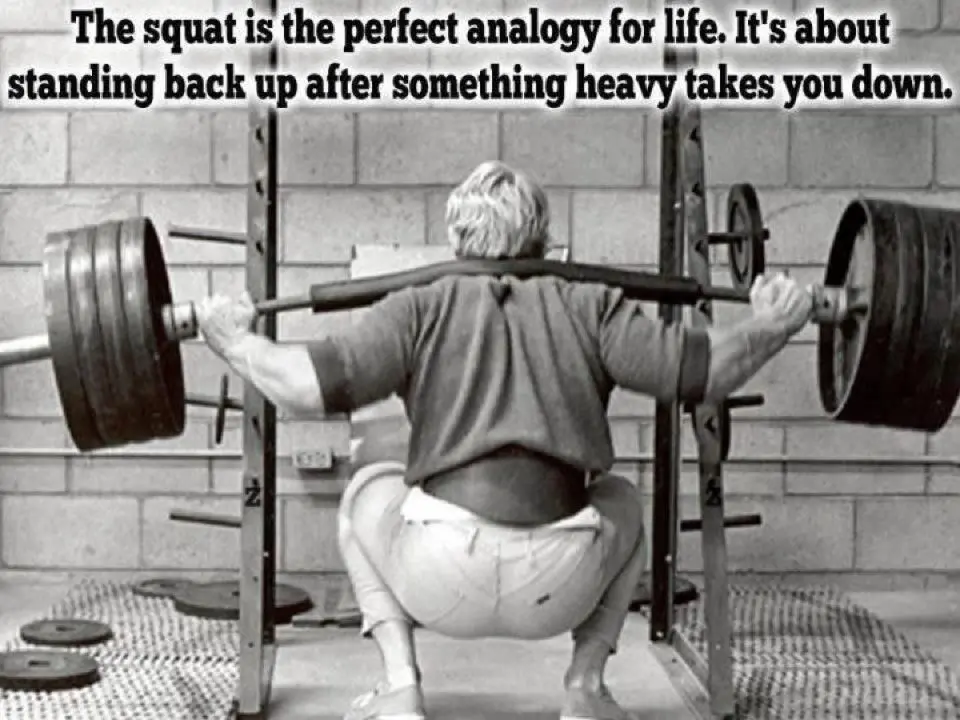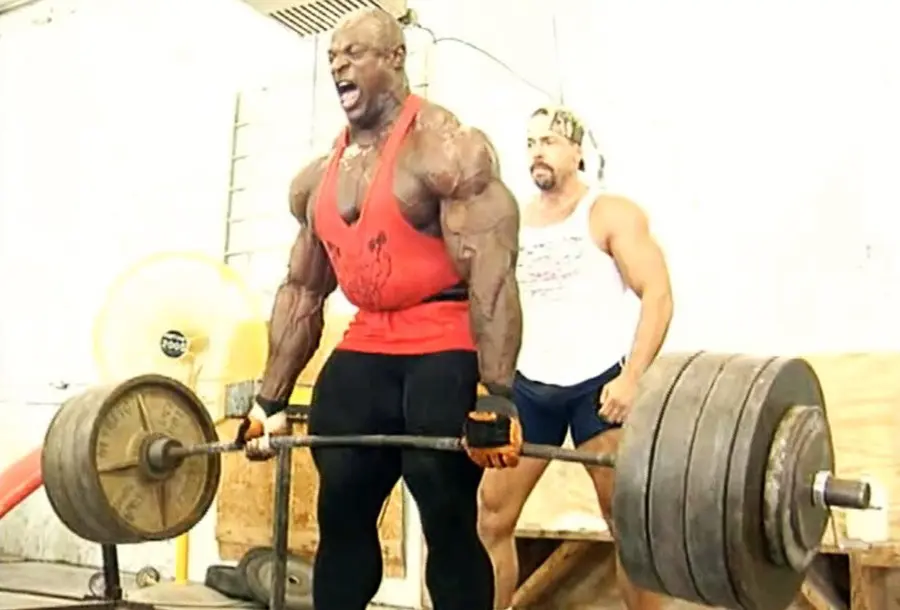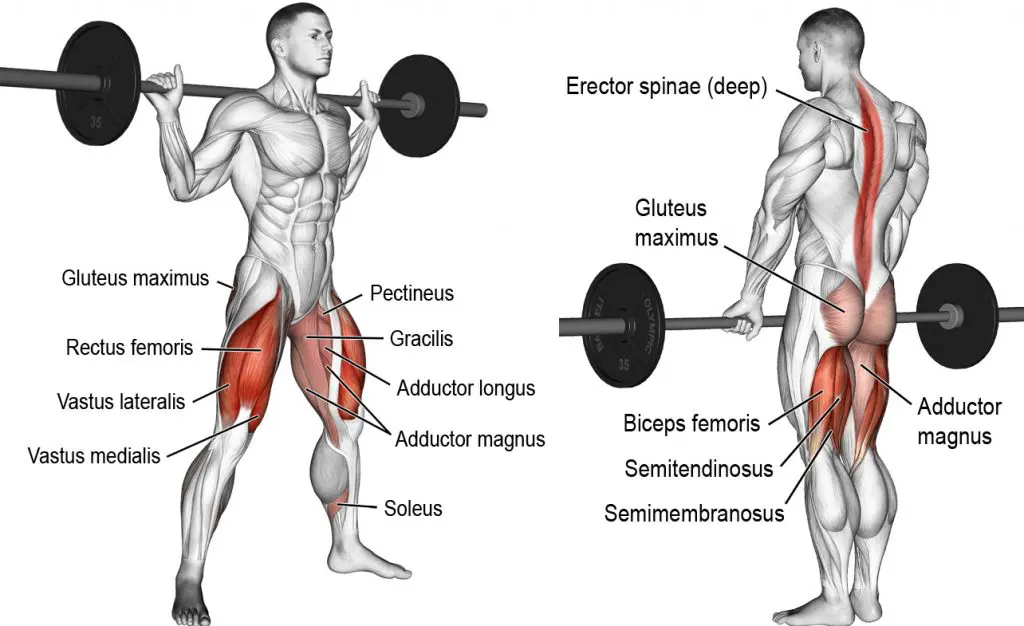Squat or Deadlift: which one is the best exercise for maximum gains?
The Squat and Deadlift are two movements which embody a lifter’s ability to develop power, strength and muscular hypertrophy. They have long been known as the epitome of compound movements and if you want to develop your body to its full potential; including them into your routine is almost non-negotiable.
We’re going to discuss in-depth, the benefits, variations, and proper lifting techniques while comparing both the Squat and Deadlift…
The Squat
If there’s a more popular lower body movement, please let us know because we’re not aware of one. The squat is arguably the undisputed king of leg development and for good reason. It is a brutal test of mental strength and is responsible for many vomit sessions and fainting spells in nearly every gym around the world.
 Which Muscles does the Squat target?
Which Muscles does the Squat target?
- Quads
- Hamstrings
- Calves
- Glutes
- Erector Spinae (Lower back)
- Core
These muscles get loads of stimulation when you perform the squat properly (We’ll get to that in a few) which make the squat a superb choice for lower body development.
The Deadlift
There’s no question that the deadlift reigns supreme for the ultimate full body strength and muscle builder. It’s the only movement where you can lift the most amount of weight possible for both the upper and lower body.

Level Up Your Fitness: Join our 💪 strong community in Fitness Volt Newsletter. Get daily inspiration, expert-backed workouts, nutrition tips, the latest in strength sports, and the support you need to reach your goals. Subscribe for free!
Why is this? Well, you don’t need as much balance or stabilizer muscles to pull a barbell off the ground. It’s an amazing movement but it’s also without a doubt, the most physically taxing on the body.
Which Muscle does the Deadlift target?
- Quads
- Hamstrings
- Calves
- Glutes
- Back (Traps, Rhomboids, Erector Spinae, Lats)
- Core
- Biceps
- Forearms
As you can see, the deadlift works a lot of muscles, even more than the Squat. However, this doesn’t mean the Deadlift is superior because both have their place in a workout routine.
Differences Between the Squat and Deadlift
An obvious difference is a setup required to perform either movement properly. Keep in mind; we’re discussing the standard version of each movement (Performed with a barbell).
One very important finding was that squats and deadlifts showed no difference for speed, power, strength and agility performance when tested during a 6-week study. (1)
Squat
The squat is performed by starting in a standing position with a barbell resting on the traps. You’ll then squat down and back up. The squat really takes the upper body out of the movement since you’re depending on lower body strength to push the weight up, while your arms only hold the bar in place. The core is important during the lift as is a reasonably strong lower back.
Deadlift
Now, the deadlift is performed by gripping a barbell on the ground, and then pulling the weight upward until you are standing erect. The deadlift requires more movement and strength of the upper body, especially since the arms and back muscles are so heavily involved. This is why the Deadlift is one of the best back exercises out there!
Muscles Worked
Another difference is that the deadlift works all the same muscles a squat does, plus a few more. Now, both movements utilize both your upper and lower body, however, the Deadlift hits the back muscles big-time! Not to mention, the biceps and forearms get a killer workout as well.

Differences are evident between both the squat and deadlift but you’d be surprised to know, that many people substitute one for the other. The reason is, we are all structurally different and we all have varying ranges of motion, mobility through the joints, and other limitations which make certain some movements uncomfortable.
With that being said, we need to experiment with different movements to find what’s most effective for us.
Benefits of Squats and Deadlifts
We already know both movements are extremely effective for developing muscular hypertrophy, strength, and power. In fact, they are so effective that for most people, there are no other substitutes.
The reason these two movements are so effective is that you can really load the bar with some big weights, and we all know heavy is key to strength and size. We all know that more resistance means more stress on the muscles, which causes hypertrophy. Progressive overload allows us to get stronger since we have to adapt to the pressures being placed on our muscles, bones and even nervous system. (2)
Squat Benefits
Squats are great because they focus on pure leg development. As mentioned before, your core and leg muscles are most involved during the lift, which means you’re not utilizing your upper body so much to get the weight up.
Now, during a typical squat, you can lower your butt deeper than you could with a Deadlift. This is because the bar allows you to move through a straight up and down motion without compromise. Whereas with the deadlift, you have to grip the bar in front of you which limits the range of motion.
Does it matter for leg development? Not at all.
It’s an insignificant difference and it may not be safe for your knees and joints to go so low during the squat anyway.
Deadlift Benefits
Many people replace squats with deadlifts because of many reasons: Lack of optimal mobility in the hips and ankles, knee pain and back pain due to the weight loads on the spine.
Deadlifts develop amazing strength and muscular hypertrophy in your legs, back, core, biceps, and Glutes. It’s a great all-around movement which many people can benefit from but you must do it properly. You cannot have muscle imbalances and progress with deadlifts so make sure to take notice of any weaknesses before attempting big numbers.
The fact that you must use your entire body to perform deadlifts is what makes them so taxing but effective at the same time. You can load the bar up with as much weight as you can lift and really stress your entire system into new growth and strength.
Performing the Squat and Deadlift
Now that you’ve learned about the benefits of each lift, we’re going to explain how to properly execute each movement so you can progress safely and starting making some real gains!
We’ll break each movement down into steps so you can have the best possible idea of how each is performed to maximum effectiveness. Keep in mind; these instructions are for performing your standard barbell versions of both the squat and deadlift.
Level Up Your Fitness: Join our 💪 strong community in Fitness Volt Newsletter. Get daily inspiration, expert-backed workouts, nutrition tips, the latest in strength sports, and the support you need to reach your goals. Subscribe for free!
Performing the Squat
- Find a proper squat rack and start with a lightweight or just the bar.
- Place yourself under the bar so that it rests on a comfortable spot on your traps (Not too high or low on your traps because you don’t want to lean forward too much and you don’t want to lean back too far either).
- Un-rack the bar and place your feet a little wider than shoulder-width apart.
- Tighten your core and Squat down while pretending you’re sitting on a bench.
- Drive with your heels and push yourself back up to the starting position.
Squats are a pretty simple movement but you want to make sure you have correct form. Your core should remain tight throughout the movement to protect your back from injuries. Always make sure you’re driving up with your heels as you do not want to push upward with the balls of your feet. This protects the knees.
How to Suat Properly:
Squats should be a progressive movement to protect the knees and back, so slowly add small increments of weight per session on your heavy days.
Performing the Deadlift
- Choose a weight you can Deadlift with relative ease.
- Position your feet slightly wider than shoulder width.
- Walk into the bar so your shins are touching it.
- Bend over to grab the bar while positioning your upper legs slightly above parallel to the ground.
- Arch your back slightly (Not rounded) and stick your butt/hips out.
- Drive up slowly in a straight vertical line while keeping the bar as close to your legs as possible (Pretend you’re rolling the bar up your shins.
- As you drive up, thrust the hips forward into the movement.
It’s important that you keep your head in line with your erect back while keeping the shoulders tight and chest forward. Never slouch or round your back or you will eventually get injured. Do not lean back or forward but remember to keep a straight, fluid line of motion throughout the movement.
We hope these points detailed the proper technique for each movement well enough for you to lift safely and effectively. If you’re a beginner, make sure you have proper form before you progress in the weights you’re lifting.
Deadlift Checklist to Avoid Mistakes:
Variations of the Squat
Throughout the article, we’ve talked about the standard squat because it’s the most widely used version. However, there are amazing variations which you should absolutely include into your routine.
Here are 4 variations of the squat you can start to include in your leg routine:
1. Front Squats
The front squat is amazing because it forces you into an upright position of Thoracic extension. They improve and develop your posture, legs, scapular adductors, core, abdominals, rectus abdominis etc. Front squats have been shown to be as effective as back squats and they also place a less compressive force on the joints, which is beneficial to those with knee problems. (3)
You’ll place the barbell across your front deltoids while sticking your chest out and up. Then you’ll perform the squat like you usually would while keeping proper form throughout the movement (You’ll be in trouble if you don’t!)
Front squats are powerful and effective!
2. Bulgarian Split Squats
It’s one of the greatest leg exercises out there… the Bulgarian Split Squat improves your balance, allows for direct axial decompression (Better for the spine) and is great for sports conditioning.
It’s a simple exercise which targets one leg at a time and you don’t need a squat rack. Just grab a bench and some dumbbells (Or just use your body weight) and you’re good to go!
3. Goblet Squat
The Goblet Squat is pretty much a front squat with a dumbbell. It hits all the same muscles and forces that Thoracic extension. It’s a great movement because you can do it anywhere with only a dumbbell in hand. It’s also a really great exercise for beginners due to only limited equipment needed and it teaches good posture habits.
4. Pistol (One-Legged) Squat
The Pistol squat is a true savior because all you need is yourself to perform this movement. You’ll develop your balance while targeting one leg at a time. The movement involves a simple squat while lifting one leg up. You can hold onto something while doing it because you will need a good balance. The pistol squat is a must in your leg routine.
These squat variations will allow you to mix things up and hit different areas of the leg muscles you may not fully target with the barbell back squat.
Variations of the Deadlift
Traditional barbell Deadlifts are pretty exhausting on their own but there are variations you can if you like variety in your workouts.
Here are 3 deadlift variations you can try out:
1. Trap (Hex) Bar Deadlift
What’s special about the Trap Bar Deadlift is that the weight is closer to your center of gravity which places less stress on the back and spine than conventional deadlifts. The Trap bar is a great choice since it allows for a natural motion, which is beneficial for many people to have a comfortable body position during the deadlift.
Many people utilize the trap bar because it allows for a more comfortable grip angle and a more free range of movement.
2. Dumbbell Deadlift
Dumbbells are a true blessing to any and every lifter. They allow for a natural range of movement and they are great for developing stabilizer muscles. Dumbbell deadlifts are usually performed with two dumbbells and in the same fashion, you’d perform a traditional deadlift.
The great thing about dumbbells is you can vary your wrist position and you can also vary the dumbbell position in relation to your body (On your sides or in front of you like a barbell deadlift).
3. Romanian Deadlift (RDL)
So the Romanian Deadlift is a fantastic variation but you must be extra careful with this movement as to avoid any injuries. The RDL is, of course, similar to the conventional deadlift except you’re not bending the knees as much and the focus is more on the glutes and hamstrings, while also providing great lower back stimulation.
The Romanian Deadlift is almost identical to a stiff-legged deadlift, except you’ll bend your knees slightly during a RDL. However, it really hits those posterior chain muscles effectively.
These variations of the deadlift will serve you extremely well in your lifting endeavors. They may not entirely replace the barbell deadlift but they are darn close!
Squat or Deadlift?
You know we can’t pick a winner! These two legendary movements have both stood the test of time and are still heavily utilized everywhere by millions of people worldwide. Both have their strengths and weaknesses and serve a purpose depending on your needs and body type.
Some people prefer the squat as it’s less taxing than the deadlift and specifically targets the leg muscles. On the other hand, some people prefer the deadlift because it causes less knee discomfort and favors those cases of “limited joint mobility”.
Both are incredible mass and strength builders and there’s no clear winner here. Experimenting is always the best option when deciding which movements work best for you.
Many people find that utilizing both movements gives the best of both worlds!









The deadlift works more body parts than any other exercise. I found however the base of my spine was vulnerable to strain, some individuals love it & do not suffer. The squat is the exercise that enables you to work harder than most. You can pause at the top & keep going. In the end each individual must honestly evaluate the pros & cons of their own experience.